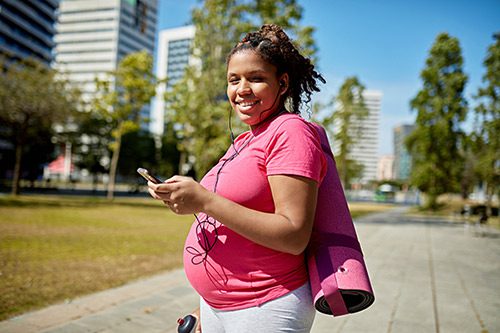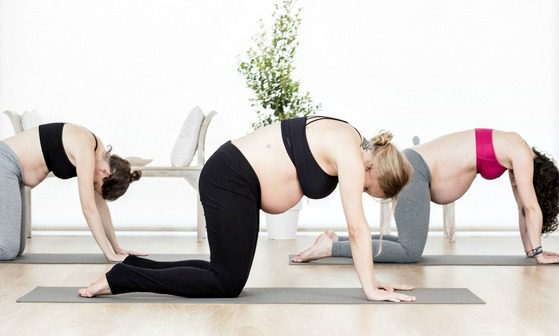
Unlike training for a marathon, there’s no need for you to spend hours getting your body ready for childbirth. By practicing a few simple exercises and techniques, you can prepare your body to bring a child into the world while helping to relieve pain and discomfort.
5 Exercises to Get Ready for Labor and Delivery
Working out is a great way to prepare your body for an easier – and possibly quicker – delivery. It can also help you get back to your pre-baby weight sooner. If you didn’t exercise before you got pregnant, now’s the time to get moving!
For tips and ideas on what workouts are safe during pregnancy, you’ll want to check out “5 Pregnancy-Safe Workouts You’ll Love.” But before starting any exercise routine, make sure to get the go-ahead from your doctor. They can provide you with recommendations tailored to you.
The best position for your baby to be born is head down and facing your back. Typically, babies will get into this position naturally by the end of pregnancy. Whether you’re an exercise newbie or a seasoned pro, here are five simple techniques and exercises to get ready for labor and delivery.
1. Deep Squat
Doing deep squats will help relax and lengthen your pelvic floor muscles and stretch your perineum. To perform a deep squat during pregnancy, start by standing with your legs wider than hip-width. With your hands pressed together in front of you, slowly squat down as far as you can go.

Performing this popular yoga pose will help lengthen your pelvic floor muscles and ease discomfort.
Begin by kneeling down and sitting on your heels. Next, lean forward slowly and stretch your arms out long in front of you. Now, breathe deeply.
For a variation, try resting your elbows on the ground in front of you and supporting your head with your hands. As you get farther along, you might need to spread your knees farther apart to create some space for your growing belly. Just be careful not to raise your hips above your heart.
3. Butterfly Stretch
This is a stretch that will strengthen and stretch the muscles in your back, pelvis, and thighs. It’ll even improve your posture! Performing a butterfly stretch is a great way to improve blood flow to your lower body, keep your pelvic joints flexible, and ease delivery.
While seated on the floor with your back straight, move the bottoms of your feet together and drop your knees. Pressing both knees gently toward the floor using your elbows, you’ll feel a stretch in your inner thighs.
Avoid bouncing your knees up and down quickly. You can use a wall to support your back if you find it difficult at first to keep your back straight. Hold this stretching position for 10 to 15 seconds and then repeat the stretch five to 10 times. Many women find that this exercise is easy to do, and it feels great.

Doing this yoga pose will help reduce discomfort and ease lower back pain. To start, get on your hands and knees with your legs and arms parallel to each other. As you exhale, round your back, tucking your chin toward your chest. Next, inhale and gently arch your back downward while looking up.
5. Kegels
Your pelvic floor muscles help support your uterus, bladder, and bowels. Toning these muscles will help ease many discomforts that late pregnancy brings, like hemorrhoids and leakage of urine, and get your body ready for childbirth.
To get started, try to stop the flow of pee when you’re sitting on the toilet but don’t tighten your abs, butt, or thighs. When you’re able to start and stop peeing, you are using your pelvic floor muscle. This is the muscle you should be contracting during Kegel exercises.
There are a couple of ways you can do Kegel exercises: either by quickly contracting your pelvic floor muscles or by holding them. To perform fast Kegels, quickly contract and relax your muscles 25 to 50 times. Take a break and relax for five seconds, then repeat the set about four times. To do slow Kegels, contract the muscle and hold for three to 10 seconds. After relaxing, repeat up to 10 times.
When you’re in these poses, let your belly relax and lightly cradle your baby. This way, they can move into the best position for birth. Every pregnant woman’s body is different, so if you find a position uncomfortable for you, you can stop doing it.
Pregnancy Exercise Video
If you want to see the best stretches and exercises to prepare your body for labor, this is the pregnancy stretching video you need!
While no exercise can induce labor, this prenatal stretching routine will help get your baby in the perfect position, open up your hips, align the pelvis, and reduce back pain. It can also increase flexibility in your pelvic and groin muscles to prepare for faster and easier labor and birth.
Try doing this pregnancy stretching video each week or every other week during your third trimester to best prepare your body for labor:
More Techniques to Prepare for Childbirth
Sleeping on your left side with your hips stacked on top of one another is the best position to sleep in during pregnancy. You can use some pillows to keep in this position. Many pregnant women love sleeping with a C-shaped or U-shaped pillow, which gives them a quiet and comfortable night.
If you wake up in a different position don’t worry; your body knows what it’s doing. Waking up in the middle of the night (while annoying) is your body’s way of making sure you are in the best position.
When you’re sitting, try to sit up straight and not in a slouched position on your tailbone. Try not to cross your legs and feet. When you’re walking or standing, allow your lower back to bend forward just a bit, to put gravity to work. But be careful not to arch your back.
Did you find this pregnancy blog helpful? Then you’ll love our pregnancy newsletter! When you sign up, you can tell us what month of pregnancy you’re in, so the newsletter is customized especially for you! Sign up here.
The newsletters cover many things, like pregnancy nutrition and how your baby is growing. They also share essential pregnancy tips. Any information you provide about yourself is kept confidential.
Editor’s Note: This article was originally published on September 4, 2014, and has since been updated.
As Vice President of Lifetime Adoption, Heather Featherston holds an MBA and is passionate about working with those facing adoption, pregnancy, and parenting issues. Heather has conducted training for birth parent advocates, spoken to professional groups, and has appeared on television and radio to discuss the multiple aspects of adoption. She has provided one-on-one support to women and hopeful adoptive parents working through adoption decisions.
Since 2002, she has been helping pregnant women and others in crisis to learn more about adoption. Heather also trains and speaks nationwide to pregnancy clinics to effectively meet the needs of women who want to explore adoption for their child. Today, she continues to address the concerns women have about adoption and supports the needs of women who choose adoption for their child.
As a published author of the book Called to Adoption, Featherston loves to see God’s hand at work every day as she helps children and families come together through adoption.




0 Comments